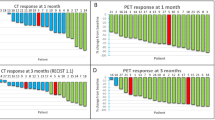Abstract
Objective
l-3-[18F]-fluoro-α-methyl tyrosine (FAMT) is transported into cancer cells by l-type amino acid transporter 1 (LAT1). The purpose of the present study is to correlate the uptake of FAMT and FDG with the cellular proliferative activity measured by the Ki-67 labeling index (Ki-67 LI) in oral squamous cell carcinoma (OSCC).
Methods
Twenty-five patients with OSCC were enrolled in this study. Both FAMT-PET and FDG-PET were performed within 4 weeks before surgery in all cases. The uptake of FAMT and FDG was compared by semiquantitative analysis with maximal standardized uptake values (SUVmax) of the primary tumors. Ki-67 LI of the tumors was analyzed by immunohistochemical staining and correlated with the clinicopathologic variables and the uptake of PET tracers.
Results
For primary tumor detection, FAMT-PET exhibited a sensitivity of 84%, whereas that of FDG-PET was 88%. In all visible lesions, mean FDG uptake determined by average SUVmax was 9.7 (range 4.2–15.9) and mean FAMT uptake was 3.5 (range 1.3–8.5). The SUVmax of FAMT tended to show a better correlation with Ki-67 LI (r = 0.878) than that of FDG (r = 0.643).
Conclusions
Uptake of FAMT correlated with cellular proliferation of OSCC. FAMT-PET may be a useful procedure to evaluate tumor proliferation of OSCC.



Similar content being viewed by others
References
Stewart BW, Kleihues P, editors. World cancer report. Lyon: WHO International Agency for Research on Cancer; 2003.
Nakasone Y, Inoue T, Oriuchi N, Takeuchi K, Negishi A, Endo K, et al. The role of whole-body FDG-PET in preoperative assessment of tumor staging in oral cancers. Ann Nucl Med. 2001;15:505–12.
Miyakubo M, Oriuchi N, Tsushima Y, Higuchi T, Koyama K, Arai K, et al. Diagnosis of maxillofacial tumor with l-3[18F]-fluoro-α-methyltyrosine (FMT) PET: a comparative study with FDG-PET. Ann Nucl Med. 2007;21:129–35.
Rege SD, Chaiken L, Hoh CK, Choi Y, Lufkin R, Anzai Y, et al. Change induced by radiation therapy in FDG uptake in normal and malignant structures of the head and neck: quantitation with PET. Radiology. 1993;189:807–12.
Yamamoto Y, Nishiyama Y, Ishikawa S, Nakano J, Chang SS, Bandoh S, et al. Correlation of 18F-FLT and 18F-FDG uptake on PET with Ki-67 immunohistochemistry in non-small cell lung cancer. Mol Imaging. Eur J Nucl Med. 2007;34:1610–6.
Buck AK, Halter G, Schirrmeister H, Kotzerke J, Wurziger I, Glatting G, et al. Imaging proliferation in lung tumors with PET: 18F-FLT versus 18F-FDG. J Nucl Med. 1993;189:807–12.
Linecker A, Kermer C, Sulzbacher I, Angelberger P, Kletter K, Dudczak R, et al. Uptake of 18F-FLT and 18F-FDG in primary head and neck cancer correlates with survival. Nuklearmedizin. 2008;47:80–5.
Inoue T, Koyama K, Oriuchi N, Alyafei S, Yuan Z, Suzuki H, et al. Detection of malignant tumors: whole-body PET with fluorine 18 alpha-methyl tyrosine versus FDG-preliminary study. Radiology. 2001;220:54–62.
Kaira K, Oriuchi N, Otani Y, Shimizu K, Tanaka S, Imai H, et al. Fluorine-18-A-methyltyrosine positron emission tomography for diagnosis and staging of lung cancer: a clinicopathologic study. Clin Cancer Res. 2007;13:6369–78.
Kaira K, Oriuchi N, Imai H, Shimizu K, Yanagitani N, Sunaga N, et al. Prognostic significance of l-type amino acid transporter 1 (LAT1) and 4F2 heavy chain (CD98) expression in stage I pulmonary adenocarcinoma. Lung Cancer. 2009;66:120–6.
Sato N, Inoue T, Tomiyoshi K, Aoki J, Oriuchi N, Takahashi A, et al. Gliomatosis cerebri evaluated by 18F alpha-methyl tyrosine positron-emission tomography. Neuroradiology. 2003;45:700–7.
Imai H, Kaira K, Oriuchi N, Yanagitani N, Sunaga N, Ishizuka T, et al. l-type amino acid transporter 1 expression is a prognostic marker in patients with surgically resected stage I non-small cell lung cancer. Histopathology. 2009;54:804–13.
Watanabe K, Nomori H, Ohtsuka T, Naruke T, Ebihara A, Orikasa H, et al. [F-18] Fluorodeoxyglucose Positron emission tomography can predict pathological tumor stage and proliferative activity determined by Ki-67 in clinical stage IA lung adenocarcinomas. Jpn J Clin Oncol. 2006;36:403–9.
Vesselle H, Schmidt RA, Pugsley JM, Li M, Kohlmeyer SG, Valliéres E, et al. Lung cancer proliferation correlates with [F-18] fluorodeoxyglucose uptake by positron emission tomography. Clin Cancer Res. 2000;6:3837–44.
Higashi K, Ueda Y, Yagishita M, Arisaka Y, Sakurai A, Oguchi M, et al. FDG PET measurement of the proliferative potential of non-small cell lung cancer. J Nucl Med. 2000;41:85–92.
Jacob R, Welkoborsky HJ, Mann WJ, Jauch M, Amedee R. [Fluorine-18] fluorodeoxyglucose positron emission tomography, DNA ploidy and growth fraction in squamous-cell carcinomas of the head and neck. ORL J Otorhinolaryngol Relat Spec. 2001;63:307–13.
Minn H, Lapela M, Klemi PJ, Grénman R, Leskinen S, Lindholm P, et al. Prediction of survival with fluorine-18-fluoro-deoxyglucose and PET in head and neck cancer. J Nucl Med. 1997;38:1907–11.
Tomiyoshi K, Amed K, Muhammad S, Higuchi T, Inoue T, Endo K, et al. Synthesis of isomers of 18F-labelled amino acid radiopharmaceutical: position 2- and 3-l-18F-alpha-methyltyrosine using a separation and purification system. Nucl Med Commun. 1997;18:169–75.
Hofele C, Freier K, Thiele OC, Haberkorn U, Buchmann I. High 2-[18F]fluoro-2-deoxy-d-glucose (18FDG) uptake measured by positron emission tomography is associated with reduced overall survival in patients with oral squamous cell carcinoma. Oral Oncol. 2009;45:963–7.
Kaira K, Oriuchi N, Shimizu K, Tominaga H, Yanagitani N, Sunaga N, et al. 18F-FMT uptake seen within primary cancer on PET helps predict outcome of non-small cell lung cancer. J Nucl Med. 2009;50:1770–6.
Myoung H, Kim MJ, Lee JH, Ok YJ, Paeng JY, Yun PY. Correlation of proliferative markers (Ki-67 and PCNA) with survival and lymph node metastasis in oral squamous cell carcinoma: a clinical and histopathological analysis of 113 patients. Int J Oral Maxillofac Surg. 2006;35:1005–10.
Acknowledgments
This work was supported by grants from the Japan Society for the Promotion of Science (21st Century COE Program-Gunma University). We also thank Dr. Toru Yamaguchi and Ms. Mayumi Tomaru for helpful suggestions with respect to immunohistochemistry.
Author information
Authors and Affiliations
Corresponding author
Rights and permissions
About this article
Cite this article
Miyashita, G., Higuchi, T., Oriuchi, N. et al. 18F-FAMT uptake correlates with tumor proliferative activity in oral squamous cell carcinoma: comparative study with 18F-FDG PET and immunohistochemistry. Ann Nucl Med 24, 579–584 (2010). https://doi.org/10.1007/s12149-010-0398-2
Received:
Accepted:
Published:
Issue Date:
DOI: https://doi.org/10.1007/s12149-010-0398-2




